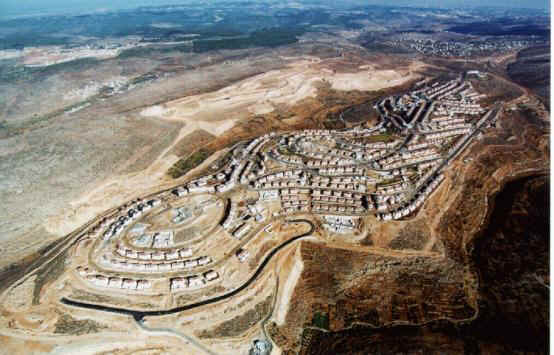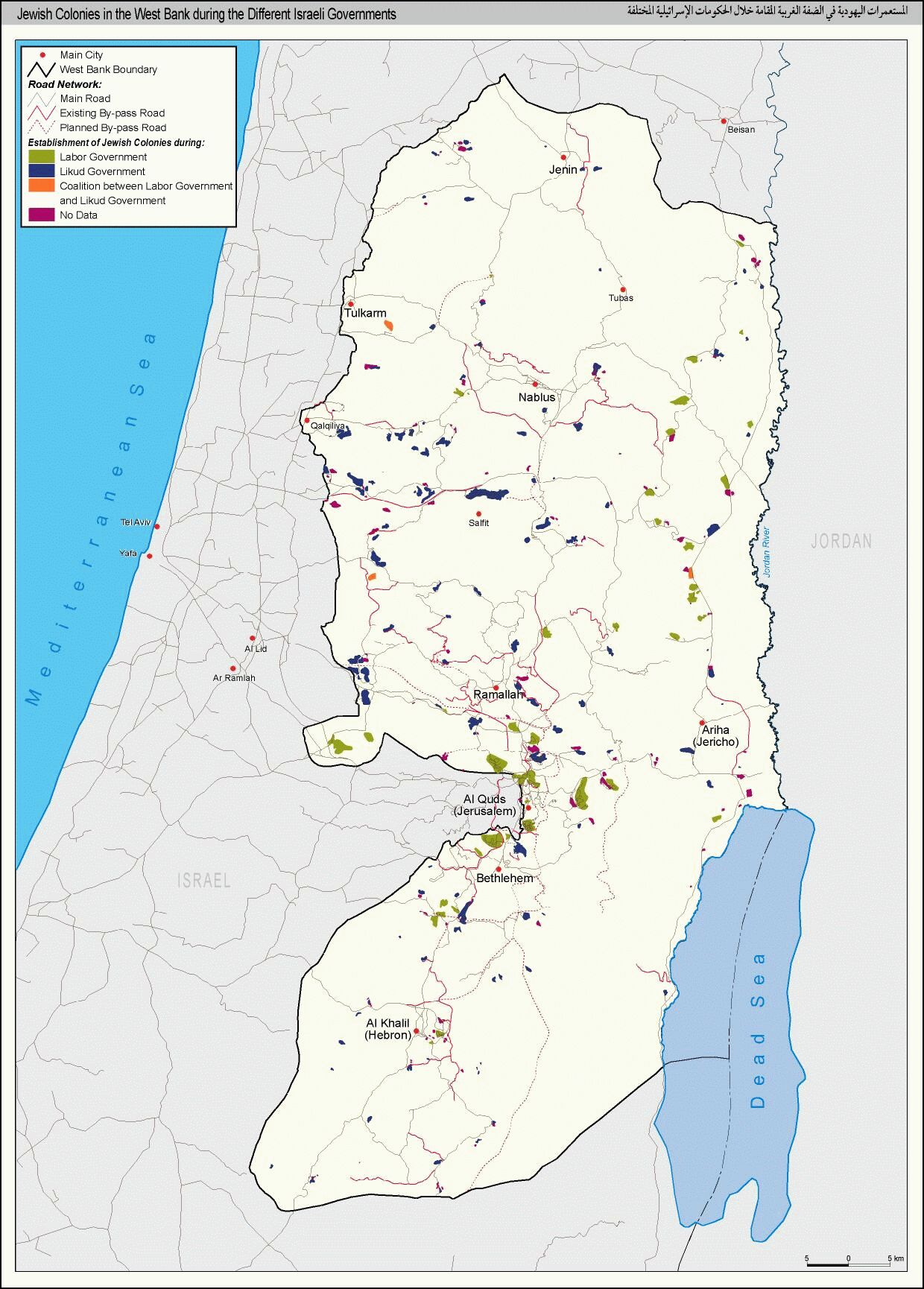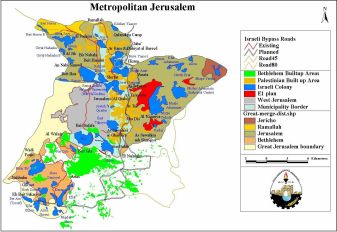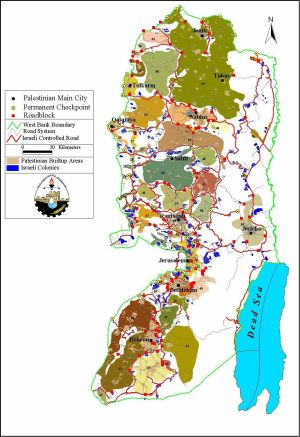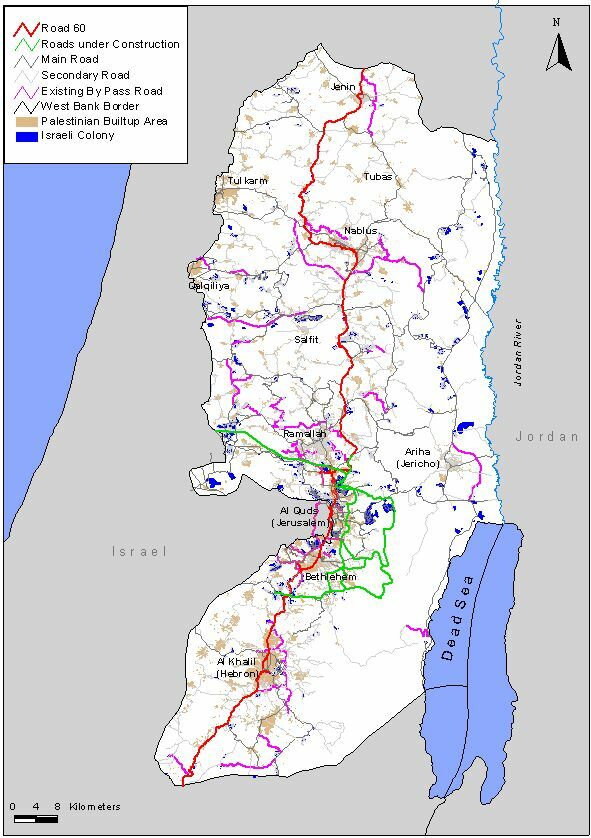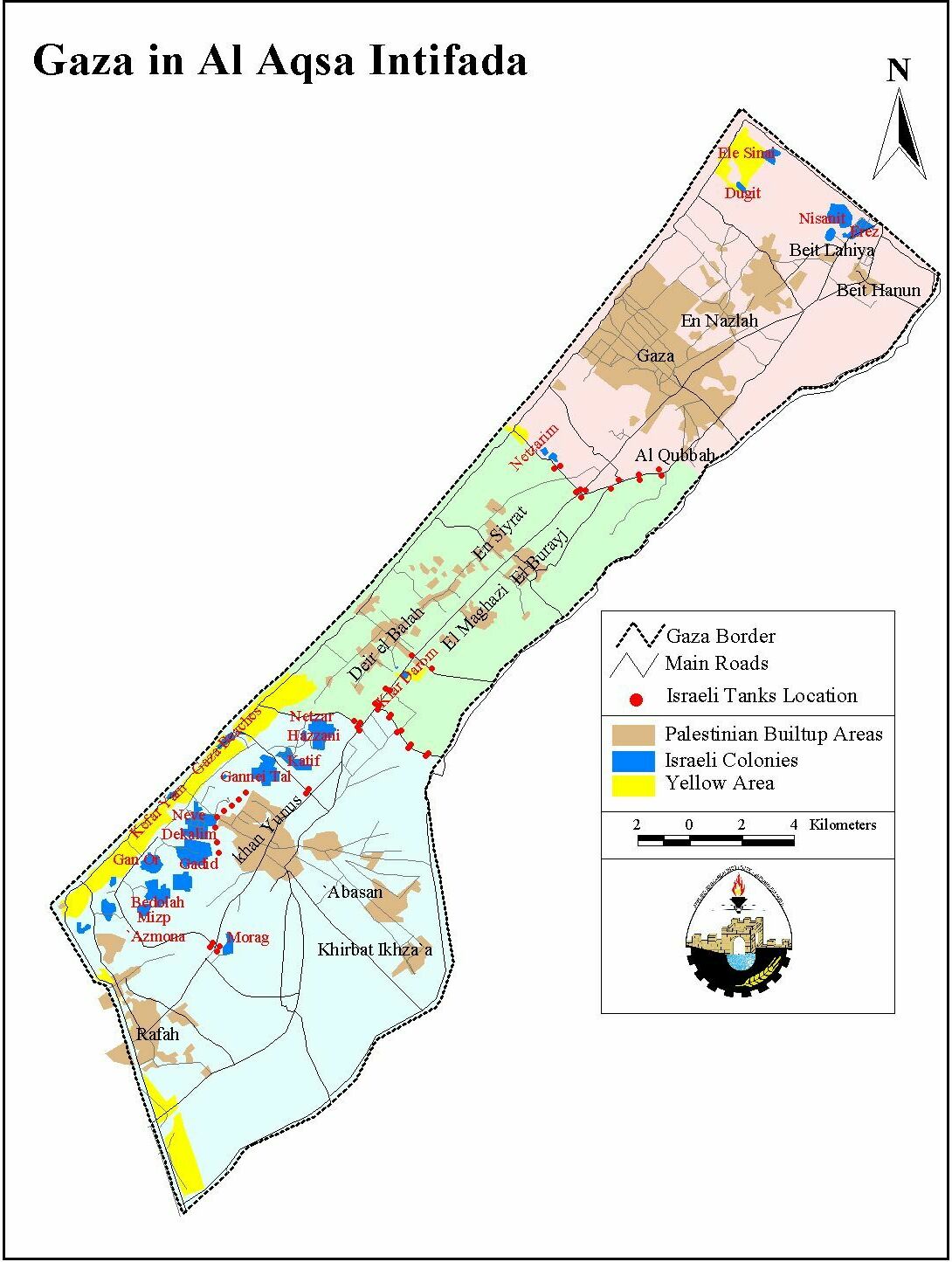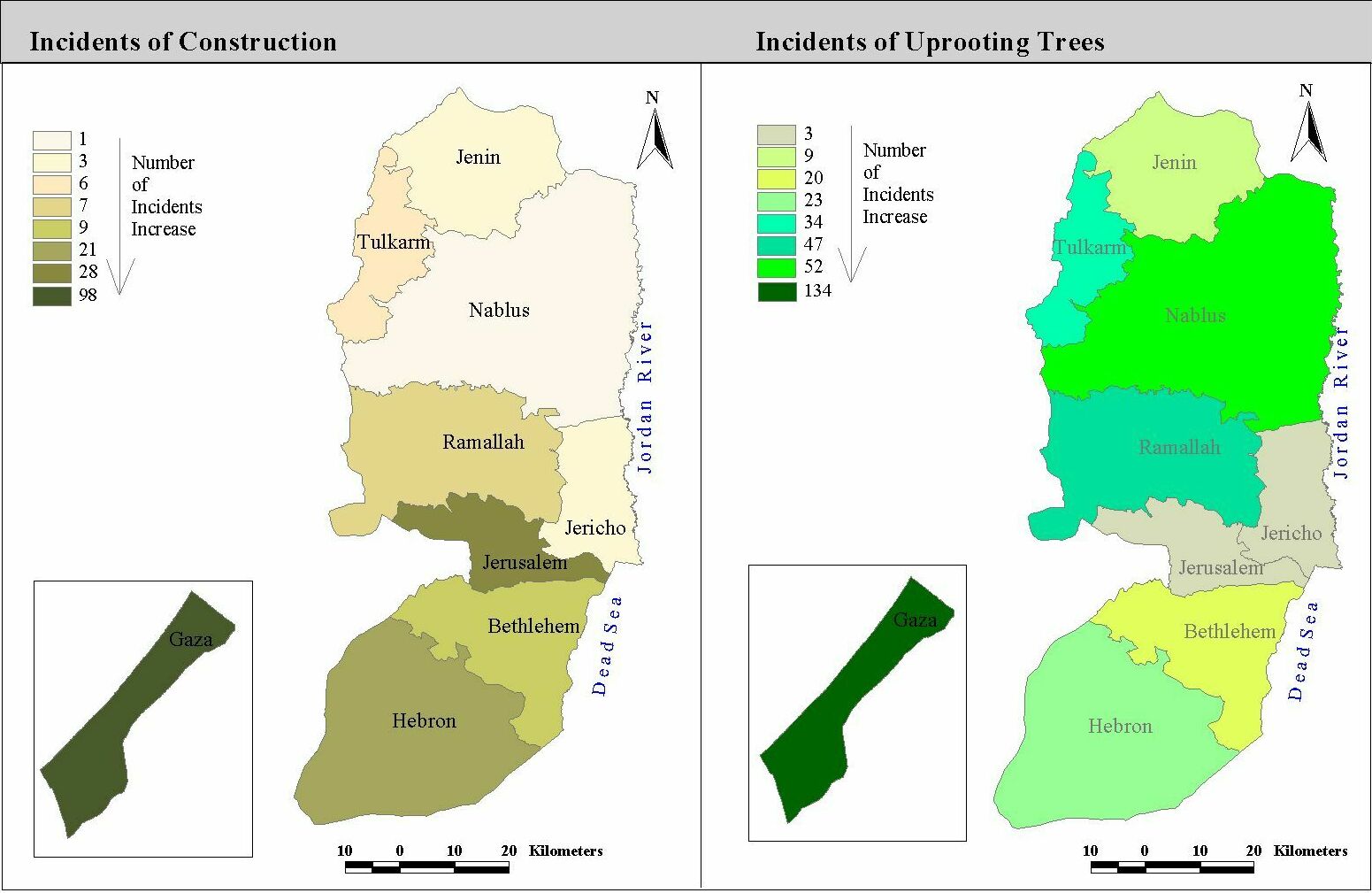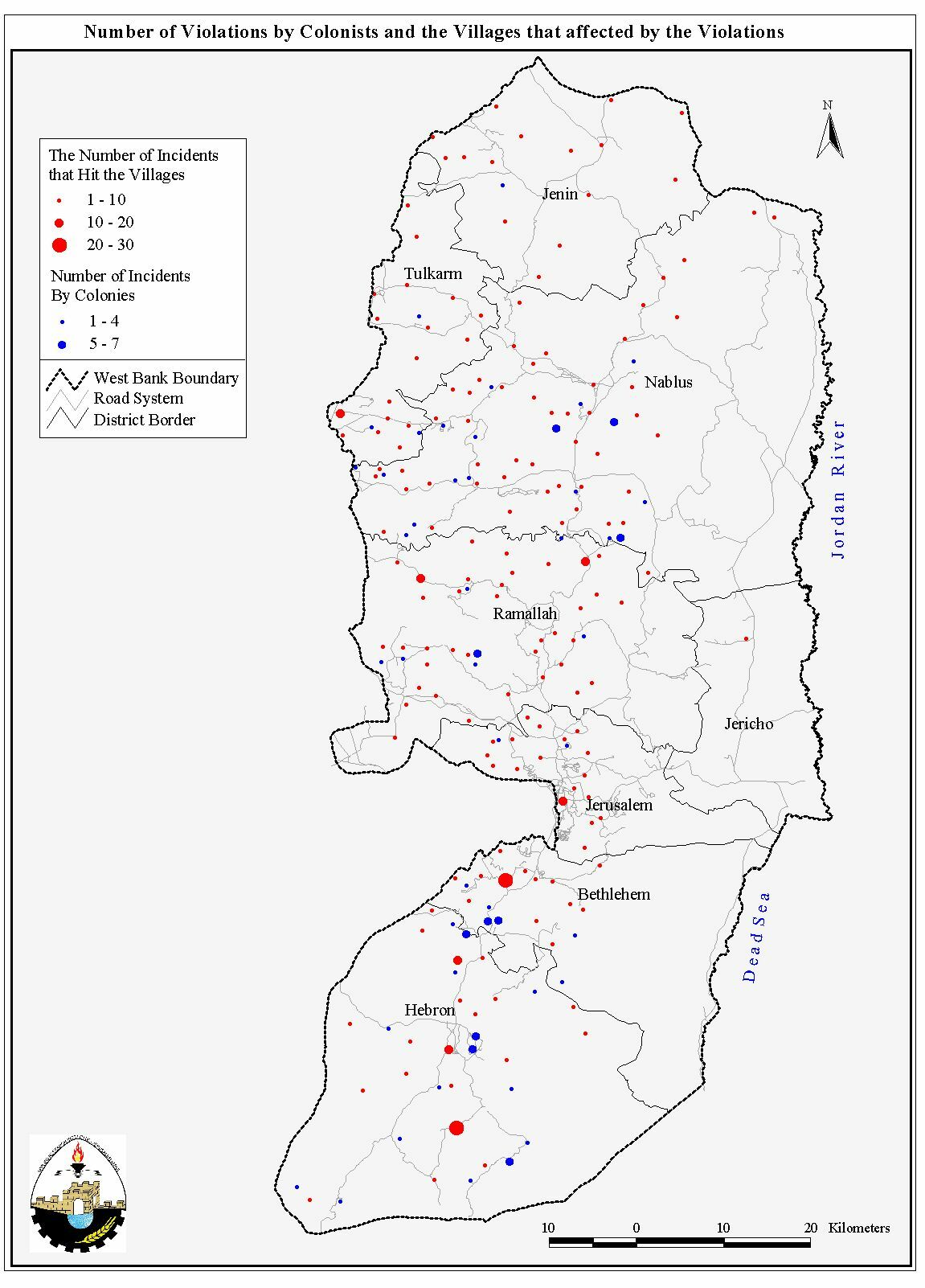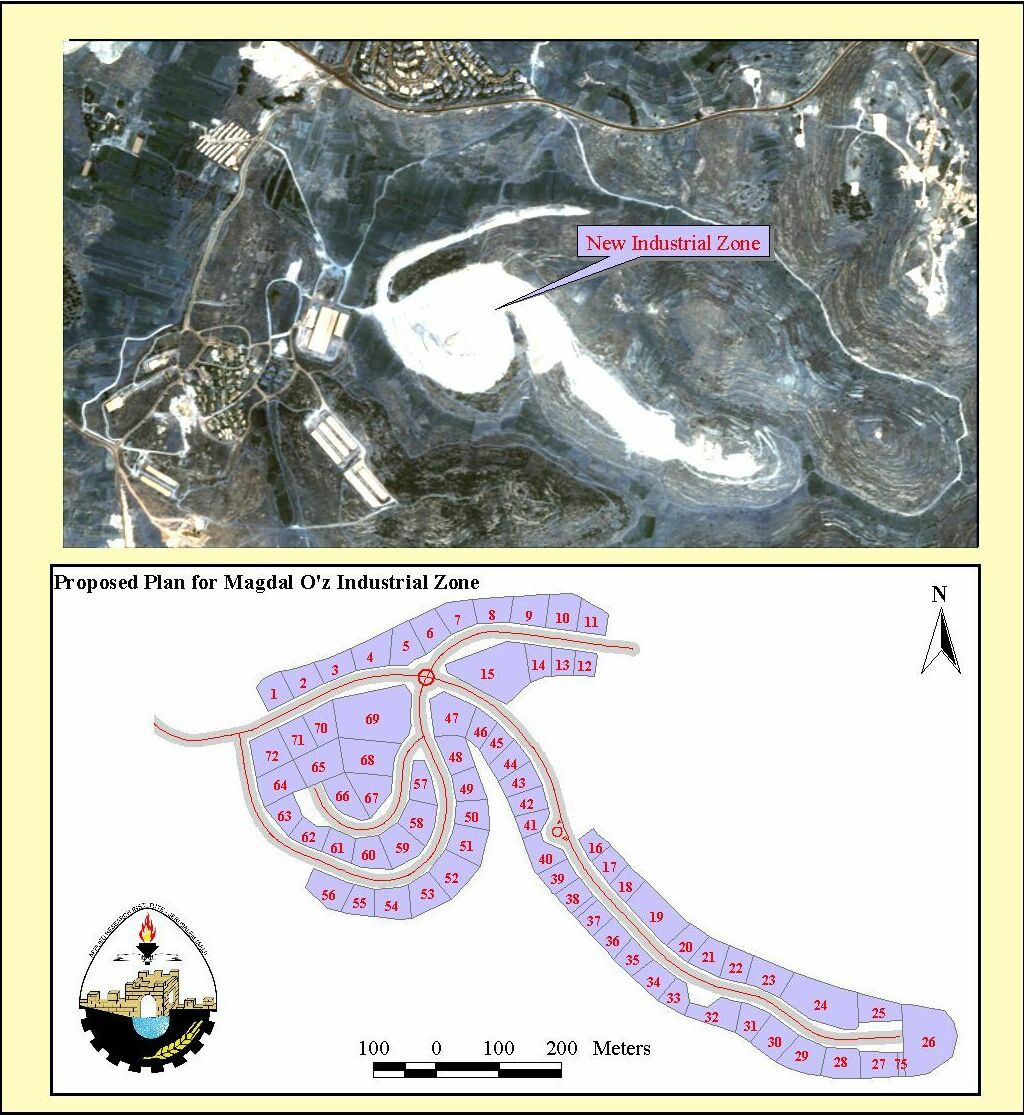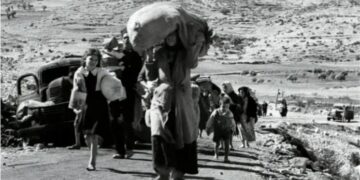Introduction
Palestinian refugees, Jerusalem, Jewish settlements, water and borders all constitute the corner stone of the Israeli-Palestinian conflict. All the previous issues, which are ranked here according to order of relevance or priority, have been postponed till final status negotiations. In fact, these issues were recognized to be a major source of conflict since the beginning of the peace process, but somehow, the negotiators and mediators were able to come out with 'constructive ambiguity' wordings aimed at avoiding confrontations on these issues from the beginning in the hope that with time, Israelis and Palestinians will build mutual confidence that will assist them to address these issues and resolve them in the final status negotiations. The final status framework was postponed until Camp David II summit when President Bill Clinton and the Israeli Prime Minister Ehud Barak, during the last few months of their office, put forth a proposal for the final status issues. The proposal opened the Pandora box of final status issues in a hasty manner with a ' take it or leave it ' approach that had no real chance to succeed.
On the ground, Israel continued expanding Jewish settlements that elevated Palestinian fears regarding Israel's genuine aspirations for a just settlement. After 8 years of negotiation, Palestinians did not feel the dividend of peace and thus, the Intifada erupted in September 28, 2000. Jerusalem, borders and settlements are all interlinked; however, it is argued here that the issue of Jewish settlements are perceived by Palestinians as the most apparent peace indicator and thus may be the pivotal cause of the Intifada and the failure of the peace process.
The Geopolitical Background
Since the 1967 occupation, Israel has either confiscated or declared as closed areas over 55% of the West Bank and 25% of the Gaza Strip, thereby placing those areas out of Palestinian reach. Palestinians are allowed to use less than 15% of their water resources. Israel has pursued a policy of colonizing Palestine through settlements in an attempt to change its demographic character. Presently, there are 18 Israeli settlements in the Gaza Strip housing an estimated 6,000 Israeli settlers, and over 200 in the West Bank with a population of more than 400,000 settlers; half of whom reside in East Jerusalem. Settlements are distributed all over the West Bank. Figure 1 shows the spatial distribution of settlements.
In Jerusalem, Israel expanded the borders of East Jerusalem from 6.5 km² to 71 km² to cover areas from Ramallah and Bethlehem districts. Those borders were drawn to include as much vacant land and as little Palestinian built up area as possible; See Figure 2.
Today Israel is in complete control of the city, yet most of the property and real estate still legally belongs to the indigenous Palestinians who have been living continuously in Jerusalem for centuries. Israel's intensive development program after 1967 has involved the construction of housing and associated infrastructure in the unilaterally annexed and expanded territory of occupied East Jerusalem. In addition, in Jerusalem's Old City, the Israeli authorities evicted immediately following the 1967 war an entire neighborhood (Al Maghareba) and leveled it to the ground in order to make way for the Wailing Wall Plaza. Over the years, Israel has been able to take control over 55 location in the old city of Jerusalem.
In 1987, the Intifada broke out carrying its message of rejecting the continuation of occupation and at the same time, calling for a resolution to the historic conflict between Israelis and Palestinians. Consequently, the Palestinian people, by and large, accepted the discourse of peaceful negotiations based on the grounds outlined in the Madrid Conference of 1991. The guiding principles of these negotiations were 'Land for Peace' and the United Nations Resolutions 242 and 338. After several rounds of formal talks in Washington, the PLO and Israel were able to come out with the historic agreement of the Declaration of Principles (DOP), which was signed in September 1993.
The DOP called for an interim period of 5 years during which the representatives of the Palestinian people and the Israeli government will initiate negotiations over the final status, which include Jerusalem, refugees, settlements, borders and water. It was also agreed upon that neither party should initiate any action during the interim period that might jeopardize the outcome of final status negotiations. The 'Oslo II' agreement, signed in Washington D.C. in September of 1995, sets out the interim stage for Palestinian Autonomy in the West Bank and Gaza, pending 'final status negotiations' which were scheduled to begin in May 1996 and finish by May 1999. The Interim Agreement states that the first phase of the Israeli military forces redeployment will be completed prior to the eve of the Palestinian elections, i.e., 22 days before the day of the elections. The further redeployments were to be completed within 18 months from the date of the inauguration of the Council. During this time, the powers and responsibilities relating to territory will be transferred gradually to Palestinian jurisdiction to cover West Bank and Gaza Strip territory, except for the issues that will be negotiated in the permanent status negotiations (i.e. Jerusalem and the Settlements). This meant that 95 % of the West Bank and Gaza should have become under Palestinian control 18 months after the inauguration of the Council.
However, on the ground, this did not happen. Stalling of negotiations and delays as well as renegotiation of what was already agreed upon led to partial Israeli withdrawals so that by the March 2000 the areas under effective Palestinian control amounted to no more than 18.2 %. The following table outlines the various stages of the interim agreements and the changes that occurred to them.
Table 1: The Redeployment percentages according to the agreements.
|
Agreement |
Date |
Area |
||
|
A |
B |
C |
||
|
Oslo II |
May 1994 |
3 % |
24 % |
73 % |
|
Wye I |
October 1998 |
10.1 % |
18.9 % |
71.0 % |
|
Wye II & III (not implemented) |
18.2 % |
21.8 % |
60.0 % |
|
|
Sharm I |
September 1999 |
10.1 % |
25.9 % |
64.0 % |
|
Sharm II (implemented in delay) |
January 2000 |
12.1 % |
26.9 % |
61.0 % |
|
Sharm III (implemented in delay) |
March 2000 |
18.2 % |
21.8 %. |
60.0 % |
|
What should have been |
1997 |
> 95 % |
0 % |
< 5 % |
In July 2000, President Clinton hosted the Israeli and Palestinian leaderships for a summit in Camp David in an attempt to revitalize the peace process through an agreement on a final status framework. This was the first real negotiations that tried to address final status issues. The Clinton parameters for a final status agreement related to settlements, borders and Jerusalem included the following:
Territory:
'Based on what I heard, I believe that the solution should be in the mid-90 percents, between 94-96 percent of the West Bank territory of the Palestinian State.
The land annexed by Israel should be compensated by a land swap of 1-3 percent in addition to territorial arrangements such as a permanent safe passage.
The parties also should consider the swap of leased land to meet their respective needs…
The Parties should develop a map consistent with the following criteria:
- 80% of settlers in blocks
- contiguity
- Minimize the annexed areas
- Minimize the number of Palestinian affected
Jerusalem:
The general principle is that Arab areas are Palestinian and Jewish ones are Israeli. This would apply to the Old City as well. I urge the two sides to work on maps to create maximum contiguity for both sides.
Regarding the HaramTemple Mount, I believe that the gaps are not related to practical administration but to symbolic issues of sovereignty and to finding a way to accord respect to the religious beliefs of both sides.
I know you have been discussing a number of formulations. I add to these two additional formulations guaranteeing Palestinian effective control over the Haram while respecting the conviction of the Jewish People. Regarding either one of those two formulations will be international monitoring to provide mutual confidence.
1. Palestinian sovereignty over the Haram and Israeli sovereignty over a) the Western Wall and the space sacred to Judaism of which it is a part or b) the Western Wall and the Holy of Holies of which it is a part.
There will be a firm commitment by both not to excavate beneath the Haram or behind the Wall.
2. Palestinian sovereignty over the Haram and Israeli sovereignty over the Western Wall and shared functional sovereignty over the issue of excavation under the Haram and behind the Wall such that mutual consent would be requested before any excavation can take place. '
Figure 3 shows a map that was given to the Palestinians during Camp David summit.
Palestinians could not accept such a proposal which totally negates UN resolutions 242 and 338 as well as the right of return and carves the West Bank to accommodate Jewish settlements and perpetuates Israeli control on large areas in East Jerusalem. On 28 September, 2000, al Aqsa Intifada erupted following the provocative entry of Mr. Ariel Sharon to the sacred vicinity of Al Aqsa. The Israeli closure forced on the Palestinian Territories since the beginning of the Aqsa Intifada has restricted the ability of Palestinians to travel and work to a degree unprecedented in the 34-year Israeli occupation of the West Bank and Gaza Strip. The internal closure separates Palestinian localities from each other and results in the hampering or complete freezing of the economic, political, educational, medical, and social service activities necessary for a healthy society. Such a cantonization of the Palestinian Territories is achieved through the use of roadblocks (including destroying the roads themselves), checkpoints, and military patrols, all built upon the skeleton of the Jewish settlements.
In an attempt to rescue the peace process, president Arafat launched an initiative to resume negotiations. In January , 2001, Israeli and Palestinian negotiators held marathon negotiations in Taba. By then, Israeli elections were close and thus, the Israeli leadership could not take the necessary decisions. The Israeli side repackaged their old positions which do not meet Palestinian aspirations. The Israeli side blamed the Palestinians for not accepting their 'generous' offer and played the percentage game claiming they offered the Palestinians more than 97 % of the West Bank. The fact is that Israel insisted on retaining the large settlement blocks of Modi'in , Gush Etzion, Ariel and Jerusalem which account for more than 12 % of the West Bank. The Taba negotiations failed and Israel continued its unilateral actions.
By overlaying maps of the checkpoints and roadblocks in the West Bank with a map of Areas A and B, a composite map was developed that interprets how the Israeli army has carried out its plan to divide the West Bank into 64 isolated areas and where those areas lie.
Figure 4: Segregation map
Beyond the immediate impact of this internal closure on Palestinian life in all West Bank districts, the areas in which the Israeli authorities have isolated Palestinians has far-reaching political implications. In an interview with Ariel Sharon by a Ha'aretz correspondent on April 12, 2001 the Prime Minister declared that he would relinquish only 42% of the West Bank for a future Palestinian state. He also declared a complete unwillingness to evacuate any Jewish settlements, the centerpiece of Israeli claims to the land. Says Sharon: 'It's not by accident that the settlements are located where they are. They safeguard the cradle of the Jewish people's birth and also provide strategic depth which is vital to our existence. The settlements were established according to the conception that, come what may, we have to hold the western security area, which is adjacent to the Green Line, and the eastern security area along the Jordan River and the roads linking the two. And Jerusalem, of course. And the hill aquifer.'
The cumulative area of the 64 cantons in Figure 4 constitutes about 40% of the total West Bank area. If Sharon has his way, this area will correspond closely with that of any Palestinian 'state' recognized by Israel in the indefinite future. Such an arrangement would, in fact, eliminate the possibility of a viable state and leave the Palestinians in permanent subjectivity to Israel. The resulting Palestinian enclaves would be completely surrounded by Israel and movement from and between these areas dependent upon Israeli approval. Furthermore, what Sharon calls the western and eastern security areas, along with the hill aquifer, are the most fertile parts of the West Bank and the richest sources of water. This would leave the Palestinians with no basis for economic development..
While the entire world is busy in its efforts to combat terrorism and make the world safer, the Israeli government was exploiting the situation by further increasing its unilateral steps and creating facts on the ground that are aggravating Palestinians aspiration for peace and justice.
During the period of July-September, Sharon's government launched its new-old policy of unilateral segregation between the West Bank and the Israeli-controlled territories. Military orders were issued to seize a total of 224,000 dunums from the northern districts, especially Jenin, Ramallah, Qalqilyia and Tulkarem. According to these military orders, isolated sectors along the 1949 Armistice Line (Green Line) were rendered closed military areas; i.e. no one was allowed to enter these areas without having a special permit issued by the Israeli authorities; See Figure 5.
These unilateral steps have an adverse effect on Palestinian society, especially for people who reside in the nearby villages and are dependent on nearby cities for their daily needs, such as employment, education, and health services. This policy of imposing restrictions on freedom of movement as collective punishment exacerbates the economic hardship among Palestinians. Palestinians see in this act another Israeli attempt to grab more Palestinian land and annex it to Israel which cast doubt about Israel's genuine aspirations for peace and its willingness to comply with UN resolution 242 and 338 which call for the withdrawal of IDF from all areas it occupied in 1967.
The recently proposed plan to create a security zone along the east side of the 1949 Armistice Line (Green Line) reveals how the Israeli government continues to mistakenly believe it can deny justice to the Palestinian people and at the same time maintain a life-style for Israelis that resembles a society at peace with its neighbors. It also demonstrates how the twin goals of separation and expansion are often held in tension.
Colonization Policy and Facts:
As discussed above, since the signing of the Declaration of Principles in 1993, Israel has followed a policy of creating de facto realities on the ground to affect the outcome of the final status negotiations. Israel has accelerated its colonizing activities by confiscating more Palestinian land to establish new settlements on hilltops and build a comprehensive network of by-pass roads. These activities have been a main source of the instability in the peace negotiations between the government of Israel and the Palestinians.
According to Israeli data there are 140 settlements in the West Bank and Gaza, however satellite images show 282 Jewish built-up areas in the West Bank including East Jerusalem and 26 in Gaza. This is excluding military sites. These built-up areas cover 154.4 sq. km (GIS database, ARIJ, 2000). The discrepancy stems from the fact that Israeli sources consider those Jewish built-up areas in East Jerusalem as neighborhoods of the Israeli-defined Jerusalem municipality and not as settlements. Currently the total number of settlers in the West Bank and the Gaza Strip number around 400,000 of which nearly 200,000 are in East Jerusalem alone.
Table 2: Land Use in the West Bank
|
|
Area in km�?�² |
Percent of the West Bank |
|
Palestinian built-up areas in the West Bank |
367.7 |
6 % |
|
Jewish settlements in the West Bank |
150.5 |
3 % |
|
Israeli Military Base |
37.9 |
1 % |
|
Closed Military Area + newly closed area |
1223.1 |
22 % |
The preceding table shows how Israel managed, in 30 years of occupation, to create half as much built up area in the West Bank as the Palestinians have in 5000 years. Through land confiscation and expropriation, Israel managed to grab over 30% of the West Bank for exclusive Jewish use. In the Gaza Strip, Israeli settlements cover 53.8 km2. This area is occupied by around 6,000 settlers only.
Jewish settlements are scattered all over the West Bank and lie predominantly to the south along the coast in the Gaza Strip. Successive Israeli governments have encouraged the development of specific blocks more than others. In the West Bank, the focus has been on the following areas:
-
The Jerusalem area to create demographic barricades in front of any Palestinian claims to it,
-
Along the West Bank's western edges so as to make the return to the 1967 borders practically impossible, and so as to make the settlements appealing to settlers, who commute to work inside Israel
-
The Jordan valley for its presumed importance to Israel's security as well as for its agricultural resources.
Furthermore, the growth of settlements is mainly geared to the formation of blocks; i.e. they grow outwards and towards each other. The end result of such a growth is the grouping of Palestinian towns and villages into three or four cantons. Indeed, the Israeli intention is to make the contiguity of any Palestinian State in the future practically unattainable.
The Labor and Likud Israeli governments have maintained progressive expansions of these settlements. To achieve this goal, they have confiscated Palestinian land, demolished their houses, and uprooted thousands of trees. Since the signing of the Declaration of Principles in 1993 and until October 2001, more than 240,000 dunums of land have been confiscated, 220,000trees have been uprooted and over 690 houses demolished in the West Bank alone. At the Applied Research Institute-Jerusalem (ARIJ), the change in the size of West Bank settlements is monitored by satellite.
Table 3: The growth of Settlement Area in the West Bank
|
Year |
Settlement Area (sq. km) |
Percent of the West Bank |
|
1997 |
108.9 |
1.92% |
|
1999 |
147.8 |
2.61% |
|
2000 |
150.5 |
2.66% |
|
2001 |
154.4 |
2.73% |
Prime Minister Sharon's administration has declared that they will not shy away from building in settlements in order to accommodate their 'natural' population growth. But table 4 below shows clearly that the growth of the settler population is far from natural. The tax breaks and cheap housing serve as good material incentives, in addition to the ideological drive means huge numbers of Israelis are moving into the occupied territories each year. It seems likely that this is the growth that the Sharon government will build to accommodate.
The Myth of 'Natural Growth'
By taking a look at the population growth in the last few years one observes the following:
The average growth rate for Jews in Israel is 2.0% per year (the rate including non-Jews is 2.5% per year). However, the population of the Jewish settlements grows at around 8.5% per year, which amounts to over four times the Israeli growth rate. Between 1996-98 there were 130 settlements that had an average annual growth of over 2%. That means that over 80% of the settlements grow at rates higher than the overall Israeli average.
According to the Israeli Interior Ministry the settlers population in the West Bank excluding Jerusalem, grew by 8% last year (Average annual growth rate within the State of Israel is less than 2.5%, Israeli Abstract yearbook, 1999). Certain settlements continue to show huge growth rates, notably Betar Illit (24.6%) and Kiryat Sefer (28.1%). The following graph shows a comparison of growth rates.
Moreover, the growth in settlements varied from one district to the other. Between 1996 and 2001 there was a remarkable increase in the settler population in Ramallah district (165% relative increase) as well as Jerusalem. After that came the districts of Bethlehem and Nablus. This indicates that, after having focused on Jerusalem for many years (as noted before, there are as many settlers in Jerusalem as there are in the rest of the West Bank), the Israelis started enlarging the settlements in the adjacent districts (namely Ramallah and Bethlehem); See Figure 6.
Table 4: Absolute and Relative Growth in Settlements 1996 – 2001, by District
|
District |
Settlers 1996 |
Settlers 2001 (estimated) |
Absolute Growth |
Relative Growth |
|
Bethlehem |
49481 |
60318 |
10837 |
22% |
|
Gaza |
5266 |
7213 |
1947 |
37% |
|
Hebron |
10409 |
13154 |
2745 |
26% |
|
Jenin |
1645 |
2133 |
488 |
30% |
|
Jericho |
1804 |
2170 |
366 |
20% |
|
Jerusalem |
168504 |
200714 |
32210 |
19% |
|
Nablus |
46302 |
56258 |
9956 |
22% |
|
Ramallah |
23010 |
60916 |
37906 |
165% |
|
Tulkarem |
6372 |
8047 |
1675 |
26% |
Bypass Roads
The term bypass roads came with the advent of the Oslo Accords and were not present before that. These roads are used by the Israelis to link settlements with each other and with Israel. In the agreements they are called 'Lateral Roads' but people usually call them 'bypass' roads because they are meant to circumvent (i.e. bypass) Palestinian built up areas. These roads are of course under Israeli control and entail a 50 to 75 meter buffer zone on each side of the road in which no construction is allowed.
The construction of by-pass roads commonly occurs along the perimeter of Palestinian built-up areas. As a result, these roads carve up the Palestinian areas into isolated ghettos and often deprive Palestinians of vital agricultural land. These practices have fragmented both land and people. This situation is very serious within the major cities of the West Bank where by-pass roads form asphalt boundaries that limit the expansion and development of the Palestinian communities, and further disconnect Palestinian communities from each other. Figure 7 marks those roads built by the Israelis since the Oslo Accords.
The construction of these by-pass roads requires the confiscation and destruction of approximately 87 km² of Palestinian land, most of which is agricultural. These bypass roads were constructed through a grant from the USA government in order to 'help' Israel in complying with the signed agreements and avoid friction between Jewish settlers and Palestinians. The role of the bypass roads became evident during the Intifada where they became the scissors that cut the Palestinian areas into 64 homelands in the West Bank and 3 homelands in Gaza; See Figure 8.
Uprooting of Trees and Deforestation
A forestation programs in the West Bank and Gaza were first implemented during the British Mandate and it accelerated during the Jordanian Administration, but were stopped completely following the Israeli occupation. According to a recent study by the Ministry of Agriculture, the total forest area within the officially designated areas decreased from 300,736 Dunums in 1971 to 231,586 Dunums in 1999. More than half of the decreased area was in Gaza, where 95% of the forests disappeared (from 42,000 Dunums in 1971 to 2,000 Dunums in 1999). About 80% of destroyed areas of official forest are attributed to the Israeli occupation as a result of establishment of military bases (2%) settlements (78%) and by-pass roads (less than 1%). Only 35 % (80,101 Dunums) of the current 231,686 Dunums of official forest area is accessible to the Palestinians, 14% of which were cut down by local people and 6% of the forest has changed to private ownership. The Israeli army and the Jewish settlers have uprooted close to three hundred thousand fruit trees mainly olive trees ..
Moreover, the Israeli authority has also completely destroyed large Palestinian agricultural fields containing thousands of Dunums of agricultural products. These actions are probably the most environmentally damaging of all the current Israeli army activities. Between September 2000 and March 2001 a total of 2975 Dunums of land were shaved by Israeli forces in the Gaza Strip (Israeli army uses this expression 'shave' to indicate complete removal of any living thing from the surface of the area).
The indirect impacts on agriculture have also been very severe. As a result of the closure, farmers have been prevented from reaching their fields and have been prevented from taking their goods to market. The agricultural inputs have become less accessible and more expensive, and transportation costs (in those cases where transport is possible) have risen. In those cases where it has been possible to sell the produce, farmers have often been forced to sell their crops at much reduced prices. The value of losses has been huge.
Furthermore, Israel declared 48 nature reserves in West Bank with a total area of 330,700 Dunums or 5.68% of the West Bank. These nature reserves are mostly distributed over the Eastern Slopes and the Jordan Valley. Palestinians question the ecological value of these nature reserves and see it as a means to deny them their rights to their land.
House Demolitions
The Israelis strictly monitor Palestinian land use within Area C. Building without a permit is forbidden, however, it is next to impossible for a Palestinian to obtain a building permit. Planted trees are consistently uprooted to discourage anything, which could lead to an attachment to the land. Vast tracts of Palestinian agricultural land, which lies in, this area continues to be confiscated by the Israelis under the pretext of the Absentee Law or security reasons.
The Israeli army repeatedly demolishes houses if they are built without a permit, or if they get in the way of Israeli construction plans (i.e., by-pass roads, settlements, military zones, etc.). At least 690 houses have been demolished since 1993 in the West Bank and Gaza. The reasons given for these activities include: building without a permit, the Absentee Law (which states that land not in use for three continuous years is subject to Israeli confiscation), and security purposes. A small portion of these was demolished as punishment for Palestinians suspected or convicted of violence against Israel. Many of these charges have been challenged in a court of law, however, the Israeli court system very seldom rules in the favor of Palestinians. Through field studies, and using GPS positioning, ARIJ has mapped the location of Palestinian houses demolished, or slated for demolition, by the Israeli government. The locations of these acts of destruction repeatedly occur along both planned and existing by-pass roads, and at the outskirts of Palestinian communities. This serves to limit the growth and movement of Palestinians, and further the Israeli commitment to creating 'facts on the ground.'
The advent of the coalition government with Sharon as its head meant that a more aggressive policy of house demolitions was going to be enacted. Indeed, as the graph shows, house demolitions increased considerably after the Sharon came to power.
Lifting The Siege
Recently, Israeli Defense Minister Binyamin Ben-Eliezer reported that the IDF began lifting restrictions imposed on Palestinian cities and villages in the West Bank and Gaza Strip. Since the outbreak of Al-Aqsa Intifada, these restrictions have divided the West bank and Gaza Strip into 67 separate cantons. In addition to permanent military checkpoints, the Israeli Government has implemented the siege by blocking roads with large concrete blocks and mounds of earth or by digging deep trenches alongside or across main thoroughfares have all made any Palestinian movement from one area to another incredibly difficult. Despite the Israeli announcements concerning the lifting of the siege, nothing significant has been implemented on the ground.
ARIJ field workers conducted a quick survey of checkpoints and road blocks in the West Bank on the 5th of January and found the following:
1. Of the 46 permanent checkpoints in the West Bank, not a single one had been lifted.
2. Of the 120 roads blocked around and within the Palestinian towns and cities, only 23 had been recently reopened.
3. Of the elevenPalestinian districts in the West Bank, restrictions had been eased in only five of them:
-
Bethlehem: 8 road blocked reopened.
-
Ramallah: 5 road blocked reopened
-
Jericho: 4 road blocked reopened.
-
Tulkarem: 4 road blocked reopened.
-
Qalqylia: 2 road blocked reopened.
4. Hebron, Jenin, Nablus, Jerusalem, Tubas and Salfit districts are still living under complete Israeli siege.
5. Palestinians, at most checkpoints, still have to and stand in line and show their documents.
6. Tens of checkpoints and road blocks are still closed for Palestinian vehicle traffic, while walking through is permitted.
7. At most of the 23 road blocks that have been 'reopened,' concrete barriers and trenches are still in place while a narrow path has been opened for vehicles to pass.
In evaluating the situation on the ground, one has to see past the Israeli propaganda, in both the press and government statements. Twenty-three out of 120 blocked roads are not even a sign of a good intention, taking into consideration the fact that 46 permanent checkpoints are still inhibiting the Palestinian territorial continuity.
The difficulties Palestinians are facing in these days are much more serious and comprehensive than a few words by the Israeli government can change. Ben-Eliezer's pursuit of restoring calm in the region will not be achieved by partially opening a few road blocks. The restoration of calm to the region must be predicated by the complete end of the harassment of the siege on Palestinian daily life.
Detailed analysis of Israeli violations in the Period February 2000 till October 2001
The data that appears in the monthly, quarterly and comprehensive reports is collected from Palestinian and Israeli newspapers, satellite images, aerial photos, fieldworkers' reports, ARIJ and LRC verification and reports from other organizations. The reports that are received are divided up according to the agreed classifications. These classifications and their definitions are as follows:
|
C = Construction; any increase in Israeli built-up areas |
|
D = Demolition; any destruction of Palestinian assets |
|
E = Expansion; any increase in land occupied by Israelis |
|
P = Plans; plans issued for acts in any other category, or attempts at violations such as attempts at seizure. |
|
R = Roads; any increase in the road network or changes in road blocks |
|
S = Seizure; confiscation, eviction, occupation and any sort of asset grabbing |
|
U = Uprooting trees |
It is worth noting that the two years covered in this report witnessed an upsurge of Israeli violence in the Palestinian Territories; such violence included massive shelling, closure and reoccupation of various parts of the Palestinian areas. However, this report does not deal with data on such Israeli violations; therefore, demolition activities as compiled in this report do not cover data on the houses or infrastructure destroyed from shelling.
Incidents are categorized as to the district they occurred in. This year (2000-2001) the districts used are eight in the West Bank (Nablus, Jericho, Jenin, Jerusalem, Ramallah, Hebron, Bethlehem and Tulkarem) and the Gaza Strip. From February 2001, the PNA's districts were officially demarcated (these include in addition to those mentioned: Salfit, Tubas and Qalqilyia) as their borders had not yet been confirmed. However, this comprehensive report continues to use the old classification of districts, so as to keep consistent with the data compilation of the first comprehensive report; this allows better comparison in the trends of Israeli colonization activities in each location of the Palestinian Territories
1.Violations
1.1 Number of Incidents
A total of 1080 colonizing incidents were recorded between February 2000 and October 2001, 745 in the West Bank and 335 in Gaza Strip. The rate at which incidents occurred varied considerably, where the overall political climate directly influences the trend. All in all, since the Al-Aqsa Intifada started in 29 September 2000, there has been a considerable increase in the number of incidents in the Occupied Territories. This rise can be seen from the average number of violations per month. Last year the average was 36 incidents per month, while this year it doubled to 72.
Chart 1: Number of incidents per month for the period February 2000 till October 2001.
Chart 2 below shows the total violations in both the West Bank and Gaza along with the major events that occurred during the period February 2000 to October 2001. As shown in the chart, overall violations increased in frequency after Ariel Sharon assumed his premiership.
Chart 2
The graph shows how Israeli colonizing activities kept increasing throughout the Intifada. The average of co lonizing activities before the Intifada was 28 incidents per month. During Barak's tenure, the rate of incidents rose to 55 while it rose further to 72 when Sharon came to power. Although the graph shows a decrease in the incidents of Israeli colonizing activities after the ceasefire declaration in June, they remained higher than the pre-Intifada level.
Furthermore, the months following this relative decrease witnessed numerous Israeli incursions and re-occupation of Palestinian territories. In fact, to the date of the writing of this report, Israel was still occupying parts of Area A.
1.2 Types of Violations
In the West Bank, the largest category of incident this year has been 'Uprooting trees'. The Intifada has seen a particular upsurge in this incident with the army becoming renowned for uprooting large areas of land (particularly olive trees) under the pretext of security. Charts 3 and 4 show how the incidents are divided between the categories in the West Bank and Gaza Strip. Although the absolute number of tree uprooting incidences is lower in Gaza than in the West Bank, when one considers the relative sizes of the two areas it can be seen that the tree damage in Gaza has been more intense.
Chart 3
Chart 4
Uprooting trees and demolition incidents increased rapidly since the beginning of Al-Aqsa Intifada in both the West Bank and Gaza. In Gaza, it is noted that both uprooting and demolition activities simultaneously peaked in the first few months of the Intifada. Uprooting and demolition incidents have been particularly significant because of Israel's plan to create buffering zones alongside by-pass roads, under the pretext of security. It is worth mentioning that most of the uprooted trees were olive trees. During the picking season in autumn, it can be noted that uprooting incidents accelerate causing detrimental economic losses for many Palestinian farmers.
Chart 5
Chart 6
The chart below gives an estimate of the numbers of trees uprooted and destroyed over the past two years in the West Bank. The huge surge in this type of destruction can be seen clearly since the start of the Intifada. However, 80% of the trees that were uprooted were damaged between March and October 2001, i.e. during Sharon's premiership.
Chart 7
Moreover, seizure and expansion incidents increased considerably during Al-Aqsa Intifada. The total numbers of seizure and expansion incidents are higher in the West Bank reaching 125 and 138 incidents respectively, whereas in Gaza they reached 42 and 16 incidents respectively.
Chart 8
Chart 9
To evaluate the expansions in settlements expansion has been also monitored from satellite images for August 1999 and April 2001 were used. The following table details the expansions in the West Bank:
Table 5: Settlement expansion between August 1999 and April 2001
|
District |
|
Settlement |
Expansion Area in Dunums |
|
Bethlehem |
1 |
Har Homa |
36 |
|
2 |
Givat Hamatos |
30 |
|
|
3 |
Betar Illit |
57 |
|
|
4 |
Nokdim |
46 |
|
|
5 |
Neve Danyyel |
280 |
|
|
6 |
Efrat |
175 |
|
|
7 |
Tekoa |
127 |
|
|
8 |
Allon Shevut |
14 |
|
|
9 |
Gilo |
22 |
|
|
10 |
Rosh Zurim |
39 |
|
|
11 |
El David (Kfar Eldad) |
32 |
|
|
Hebron |
1 |
east of Maale Havar |
22 |
|
2 |
Shima |
43 |
|
|
3 |
Negohot |
17 |
|
|
4 |
Maale Havar (Pene Hever) |
3 |
|
|
5 |
Maale Amos |
134 |
|
|
6 |
Maon |
37 |
|
|
7 |
Migdal Oz |
132 |
|
|
8 |
Kfar Etzion |
46 |
|
|
9 |
south east of Qiryat Arba |
8 |
|
|
Jenin |
1 |
Kaddim |
48 |
|
2 |
Mevo Dotan |
16 |
|
|
3 |
Shaked |
118 |
|
|
4 |
west of Hannanit |
81 |
|
|
Jericho |
1 |
Beit HaArava |
13 |
|
2 |
Vered Yeriho |
18 |
|
|
3 |
Noomi |
81 |
|
|
4 |
north Dead Sea |
25 |
|
|
5 |
Lido Yehuda |
47 |
|
|
Jerusalem |
1 |
Adam (Geva Benyamin) |
111 |
|
2 |
Kalya |
15 |
|
|
3 |
Mishor Adummim |
90 |
|
|
4 |
Mevaseret Ziyyon |
8 |
|
|
5 |
north of Mishor Adummim |
12 |
|
|
6 |
Mizpe Yedude |
56 |
|
|
7 |
east of Ramot |
57 |
|
|
Nablus |
1 |
Homesh |
39 |
|
2 |
east of Itmar |
7 |
|
|
3 |
east of Itmar 2 |
30 |
|
|
4 |
east of Eli |
178 |
|
|
5 |
south of Shavei Shomron |
254 |
|
|
Qalqiliya |
1 |
Zufin |
106 |
|
2 |
Alfei Menashe |
369 |
|
|
3 |
west of Zufin |
2 |
|
|
4 |
west of Alfei Menashe |
23 |
|
|
5 |
north east of Immanuel |
27 |
|
|
6 |
Giv'at HaMerkaziz |
42 |
|
|
7 |
north of Karne Shomron |
69 |
|
|
8 |
south east Kedumim |
277 |
|
|
Ramallah |
1 |
Talmon |
9 |
|
2 |
Talmon C |
16 |
|
|
3 |
Dolev |
553 |
|
|
4 |
Naaleh |
117 |
|
|
5 |
Mevo Horon |
28 |
|
|
6 |
South of Shilo |
118 |
|
|
Salfit |
1 |
Nofim |
3 |
|
2 |
Ginnot Shomeron |
68 |
|
|
3 |
Kiryat Netafim |
14 |
|
|
4 |
Barqan industrial |
60 |
|
|
5 |
Yakir |
78 |
|
|
6 |
Arial |
94 |
|
|
7 |
Elkana |
238 |
|
|
Tubas |
1 |
Beqaot |
169 |
|
Tulkarm |
1 |
Avnei Hefetz |
200 |
|
2 |
Hermesh |
9 |
|
|
3 |
Enav |
9 |
|
|
4 |
west Salit |
101 |
|
|
Total |
5400 |
||
2. Location
2.1 Districts
As mentioned in the introduction, the incident events in the West Bank are categorized according to the district in which they occur. Eight district divisions were used. By counting the number of incidents occurring in each district we can locate which areas suffered most from these kinds of incidents;
See Figure 9, Figure 10, Figure 11, Figure 12.
Chart 10 shows the percentage of the total number of incidents in each district in the West Bank. This includes incidents by both settlers and the Israeli authorities. Hebron experienced the largest number of incidents at 152. Ramallah, Nablus and Bethlehem were the next worst affected with 145, 127 and 102 incidents respectively.
Chart 10
More detail is provided by the break down of incidents into violations in each district. Nearly 51% of all tree uprooting in the West Bank occurred in Nablus (26%) and Ramallah (25%).
Chart 11
Jerusalem was notably affected by demolition incidents as shown in Chart 12. Such a high rate of demolition incidents (35%) is due to the fact that Jerusalem is still largely under Israeli control, where Jerusalem residents are subjected to discriminatory policies, particularly in their rights of residence and construction. Such policies fall under a larger Israeli occupation plan to restrain Palestinian demographic growth in Jerusalem.
Chart 12
2.2 Villages
Certain villages, like certain districts are more severely affected by Israeli violations than others; see Figure 13.
-
In Bethlehem District, 30 of the total 83 incidents (36%) affected Al-Khader village. According to the 1997 Palestinian census*, this village has about 5% of the population of Bethlehem district. This small portion of the population suffers far more than the other 95% of the district. Moreover, 61% of total incidents in Bethlehem district occurred in Nahalin, Husan, Tuqu', Beit Jala, and al Khadr village.
-
In Hebron District, 27 of the total 124 incidents (22%) affected Yatta village. 31% impacted Hebron city, Beit Ummar and Halhoul .
-
In Jenin District, 41% of the total 37 incidents occurred in Ya'bed, Jenin city and Barta'a village.
-
In Nablus District, 14% of the total 142 incidents occurred in Mas-ha, Jalud and Kafr Al-Deik.
-
In Ramallah District, 21% of the total 160 incidents occurred in Sinjil, Aboud and Ras-Karkar villages.
-
In Tulkarem, 30% of the total 115 incidents occurred in Qalqylia city, Isla and Shoufa villages.
* Palestinian Central Bureau of Statistics *
3.Violators
The 'violators' categorization is very broad. It is merely meant to single out the number of incidents instigated by the settlers. More often than not, settlers commit their violations with army protection. This is important to note because it shows the complacency of the Israeli authorities when it comes to aiding settlers engaged in acts of violence against the Palestinians.
In the West Bank 270 of the 745 incidents (40%) were carried out by settlers. In the Gaza Strip, settlers were responsible for 27 out of the 335 incidents (8%).
Chart 13 shows the percentages of settlers in each district in the West Bank and Gaza, based on the population figures from 1998*. Comparing this chart with the number of incidents carried out by settlers in each district (Chart 14) shows that the number of settler violations in particular district does not correlate with the number of settlers there. For example Jerusalem District has 47% of the settler population but only accounts for 4.4% of the settler violations.
*Israeli Central Bureau of Statistics*
Chart 13
Chart 14
Charts 13 and 14 can be used to calculate the activity of the settlers in each district, by dividing the percentages in Chart 13 by those in Chart 14. The ratio of the percentage of incidents in a district to the percentage of settlers in a district allows us to compare the number of settler violations relative to the population size. This number indicates which settlers are more aggressive relative to others.
Chart15
The higher the ratio shown in Chart 15, the greater the number of violations per settler is. It is clear that the settlers in Hebron and Gaza are by far the most disproportionate violators. Settlers in Nablus, Ramallah and Tulkarm are the next most active violators.
It is shown in Chart 15 that settlers in some districts are worse than settlers in other districts. By examining the raw data, one can also single out which particular settlements have the worst records for violations. In the West Bank, 12 settlements have each been responsible for five or more incidents, where Yizhar settlement (in Nablus district), Gush Etzion settlement (in Bethlehem district), Efrat settlement (in Bethlehem district) and Talmon settlement (in Ramallah district) having by far the worst record, with 7 incidents each.; see Chart 13. The settlers of Ma'on (in Hebron district) were responsible for six incidents. Efrat and Gush Etzion (Bethlehem), Yizhar (Nablus) and Talmon (Ramallah) settlements were each responsible for seven incidents.
Financial Incentives offered to Israeli Settlers:
- Settler family income in Alkana settlement reached 17,000 NIS per month in 2000, whereas the average Israeli income in 2000 did not exceed 10,300 NIS per month.
- Settlers receive a tax exemption of 7%
- Expenditure on security reached 900 million NIS/ year
- Industries in settlements receive $46 million in grants and 22 million NIS allocation from the Ministry of Industry.
- Settlements received $18 million from the Ministry of Tourism.
- Every settler is granted 80,000 NIS from the Ministry of Housing.
- In 2000, the IDF spent 150 million NIS on roads in settlements while 22 million NIS came from the Transportation Ministry.
Most Recent Colonizing Activitie
Israeli bulldozers, guarded by tanks, have recently begun their first stage-work towards opening a new military road, which consequently will cause the destruction of 9 square kilometer of agricultural land. Israel, by constructing this road, is further expanding the illegal boundaries of Jerusalem, annexed after the 1967 war.
Till December 27, data calculated from field surveys are as follow
|
Total length of the new military road |
8.2 Km |
|
Paved |
2.5 Km |
|
Under construction |
6 Km |
|
Total length of the Existing military road |
2 Km |
Source: ARIJ GIS
2- In Bethlehem:
About 200 Dunums of Beit Ummar area has been fully confiscated for the sake of establishing 'Migdal OZ industrial zone'. The confiscated agricultural area lies on the northern side of Hebron Mountains and belongs to farmers from Beit Ummar and Beit Fajar villages. The villagers filed suites against the military order; they raised the appeal via humanitarian organization but never got a response from the Israeli High Court of Justice. Meanwhile, on the ground, the Israeli bulldozers have continued their work. The proposed industrial zone 'DER 'ALA' or [Bricot] will consist of around 72 industrial blocks that will be stemmed on part of the Palestinian town of Beit Ummar; see Figure 14.
3- In Gaza strip:
A House demolition campaign in Rafah. Under the complete darkness at a cold night on Thursday 10/1/2002, the Israeli military forces accompanied by bulldozers stormed a crowded populated quarter at Rafah Refugee camp and demolished 73 houses without evacuating any of its contents of furniture, equipment and others. At the sunrise of the next day, 123 families totaling more than 800 people were becoming homeless and refugees again. Of the last version of refugees, 350 students did not find their books, clothes and school bags. They were not able to go for their final mid-year exams.
A House demolition campaign in Al Isawiya. The residents of Al Isawiya woke up on the morning of 14/1/2002 at the noisy sound of huge bulldozers and more than 500 security men surrounding the village from all its entrances. They started demolishing 9 houses composed of 13 apartments belonging to 13 families totaling 78 people more than half of them are children.
5- In Jerusalem:
Two hundred houses are due to be build inside the old city, near Bab Al-Sahreh. Arial Sharon first declared this colonizing plan when he was the housing Minister back in 1990. His successor in Luked Party, Benjamin Netanyahu, began the construction process in 1998 followed by inhabiting 12 Israeli settlers. The plan behind this action is to get into the Islamic Quarter in order to terminate the on ground partitions of the old city, which have been agreed upon during Camp David negotiations.
Final remarks
It is important to point out that throughout the Al Aqsa Intifada, events have been unfolding at such a quick pace that monitoring and recording them has proved a very difficult task. This is especially true when it comes to checkpoints and roadblocks. Because there has been international condemnation every now and then over Israeli policies, the Israelis have been playing a game of cat and mouse with the international media. Whenever they feel that the international media is unaware or looking the other way, they implement stringent restrictions on the Palestinians. However, when the world is watching, Israel puts on the cloak of civility and lifts the restrictions. Therefore, on several occasions, monitors and international solidarity groups come to the occupied territories to witness the Israeli abuses only to find that there is nothing. But after they are gone, the true face of Israel comes to light. Unfortunately, it is only the Palestinians that get to see this face.
Conclusion
It is important to recall here that United Nations Security Council Resolutions 242 and 338 ' emphasize the inadmissibility of the acquisition of territory by war and the need to work for a just and lasting peace in which every State in the area can live in security and affirms that the fulfillment of Charter principles requires the establishment of a just and lasting peace in the Middle East which should include the application of both the following principles:
-
Withdrawal of Israeli armed forces from territories occupied in the recent conflict;
-
Termination of all claims or states of belligerency and respect for and acknowledgement of the sovereignty, territorial integrity and political independence of every State in the area and their right to live in peace within secure and recognized boundaries free from threats or acts of force;'
These resolutions also ' affirm further the necessity for achieving a just settlement of the refugee problem; and requests the Secretary General to promote agreement and assist efforts to achieve a peaceful and accepted settlement in accordance with the provisions and principles in this resolution;'
All Israeli settlements in the West Bank and Gaza are illegal according to International Law. Article 49 of the Fourth Geneva Convention specifically states that: 'The Occupying Power shall not deport or transfer parts of its own civilian population into the territory it occupies'.
For the Palestinians, 'Madrid' and 'Oslo' heralded the prospect of a State, and guaranteed an end to the occupation and a resolution of outstanding matters within an agreed time frame. Palestinians are frustrated at the continued growth of settlements and at their daily experiences of humiliation and disruption as a result of Israel's presence in the Palestinian territories. Palestinians see settlers and settlements in their midst not only as violating the spirit of all agreements ratified by both sides, but also as an application of force in the form of Israel's overwhelming military superiority, which sustains and protects the settlements.
Furthermore, the ongoing fragmentation of Palestinian land and communities into disconnected cantons combined with the frequent collective punishment of closures, house demolitions, withdrawal of identification cards, the confiscation of private property will and the military bombardment of the past year impose a physically unsustainable situation.
Any resolution to the conflict should not take into consideration the facts that Israel has illegally created on the ground (as they are always manipulated by Israeli colonization and occupation policies) but should take into account justice as a premise for sustainable peace. It is becoming clear that the solution for the conflict requires the dismantlement of all settlements as well as the displacement of the settlers without any exception, including what the Israeli government alludes to as 'neighborhood'. This is not unrealistic, unthinkable but inevitable. Israel can easily absorb the 400,000 settlers inside Israel. As a matter of principle, Israel should not be allowed to get away with its defiance of the international legitimacy and thus, the American attempt to consolidate the settlements will not be acceptable to Palestinians.
Israel has recognized the geographical integrity of the West Bank and Gaza Strip, i.e. there should be tangible contiguity between them. This contiguity could be achieved through minor territorial exchange and dismantlement of Jewish settlements to facilitate the absorption of Palestinian returnees.
To reiterate, a lasting peace can only be based on United Nations Resolutions 242 and 338, in which a fully sovereign Palestinian state will be established based on the Palestinian land occupied by Israel in 1967, neighboring a secure and independent Israeli state. For Israel to demonstrate its readiness to comply with these resolutions and the Mitchell commission report , Palestinians need to see actions on the ground including:
-
Lifting of the one year old blockade imposed on Palestinians
-
Abolition of the closed areas orders including the separation zones
-
Total freeze on all settlements expansions and by pass roads construction
-
Beginning of dismantling settlements in hot spots such as Gaza and Hebron
-
Dismantlement of all 'illegal' outposts
-
Allowing international inspection of all settlement activities
-
Cancellation of all privileges and incentives given to settlers.
References
ARIJ (Applied Research Institute-Jerusalem), Geographic Information System (GIS) Database, Bethlehem, 1996-1998.
Israeli-Palestinian Interim Agreement on the West Bank and Gaza Strip Oslo II, Washington, Ministry of Foreign Affairs, Jerusalem, September 1995.
PCBS (Palestinian Central Bureau of Statistics), Preliminary results for the census of population and Establishments-1997.
Prepared by:
The Applied Research Institute – Jerusalem



